Abitibi Canyon colony memories
As recalled by Richard
(Richie) Frampton
.
| |
|
Introduction to this web
site:
Recently I started looking through a number of old photographs of our
years living in the Abitibi Canyon colony (1939 t0 1948). Looking at
these images triggered a lot of memories and I thought I would share
some of them here.
I have divided
this web site into a number of pages, first to speed up the viewing and
second to separate the pictures into categories. This page is an
introduction
of my own recollections. I have created several other pages that include:
-
Images of the Colony - views of
the Canyon colony and the people - including several WWII pictures of
the Civil Guard (armed and dangerous Hydro employees).
-
The Hydro Electric Power Commission
of Ontario train that connected
Fraserdale to the Colony.
|
|
|
|
|
These memories
are based on my years in the
Abitibi Canyon
colony - 1939 to 1948
by
Richard H Frampton Jr. (nickname - Richie)
Introduction:
My parents and I moved to the Abitibi Canyon Hydro colony early in 1939.
We lived there for 9 years, moving back to North Bay in 1948. Recently I
discovered a few pictures my father took over the 9 years we lived in the
Canyon. The pictures brought back a lot of memories and I thought I would
share some of them. My memories are from my childhood, and in a sense
would not be like those of an adult living in the Canyon during the same
period.
I was 4 years old when the
Canyon became our home. I attended school there to the end of grade 7. It
was a great place to grow up. Going to school in a one room school was
an terrific experience. Actually there were two rooms, grades 1 through 8
in the large classroom and 9 through 13 in the smaller one.
|
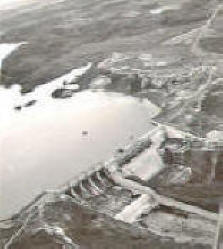
|
Powerhouse and colony
in 1945 |
|
|
1947/48 was my last year at
Canyon school. Because of the increased population of school age
children, another classroom was added using a room in one of the colony
houses. It was a small classroom, actually the living room, with just a
few students. In the new classroom and in grade 7 there were Gloria Rennick, Ann Armstrong and me.
The remaining students were Angus Armstrong, Billy Cox and another person
who's name I don't remember.
My father loved photography and to my knowledge, most of the pictures here
were taken and developed by him. We had a darkroom in the coal cellar
where he developed his pictures and even made postcards that were sold in
the Colony's general store. Unfortunately many of the pictures have
deteriorated and can not be recovered. I have used the pictures that I
have to give a flavour of Canyon life in the early '40s.
|
|
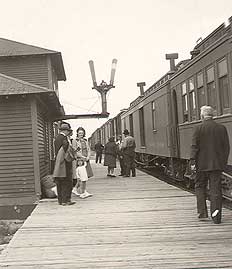 |
| In 1939, after a long train
trip from Cochrane, we arrived at Fraserdale. The picture at the
left shows
the mixed freight and passenger train that operated twice a week
between Cochrane and Moosonee. It was operated by the Timiskaming
and Northern Ontario RR or T&NO - better know as the Time No Object
Railway. |
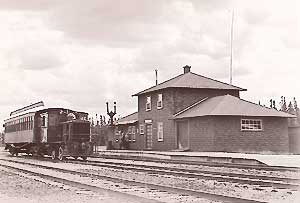
When the train left the
station for Moosonee we had our first glimpse of the train that
would take us to the Colony, 3 1/2 miles away. The train was
operated by Ely Leblanc, one of the interesting personalities that
I would eventually get to know.
On the side of the
engine were large letters - HEPC - I was told that the letters
stood for "Help Ely pass Cochrane". |
|
|
Our first view was from the
windows of the antique (even then) coach as the train came down the grade into the Colony.
This picture was taken several years after we arrived. When we arrived
in 1939, there were still steam locomotives and other pieces of
construction equipment on the sidings. During the war, any metal scrap
was salvaged and eventually all the old equipment was sent south to be
turned into war material. |
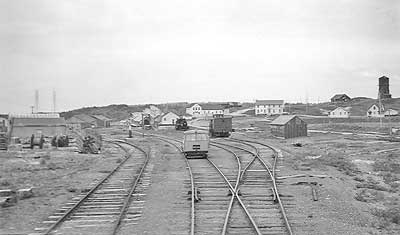 |
|
The picture makes the Canyon
colony look like a drab and colourless place, but in reality, the long
summer days made everything grow and the place was alive with wild
flowers, berries and insects!!! In the winter there was a lot
of activity in the recreation hall and hockey rink, along with skiing,
tobogganing and lots of fun activities. These were the days before the
road, television or the internet. We made our own fun!
Trees were cleared near the
colony as protection against forest fires. That's why you don't
see many trees in these pictures. |
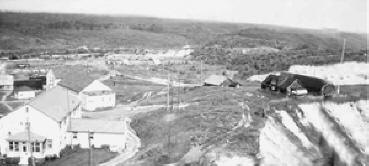
Our first house was
the dark building , second from the right in this picture. As I recall, it was covered
in tar paper. The larger building next to it housed guards that
protected the power plant during the war. (WWII)
|
| About 130
people lived in the colony when we arrived. There were about 30
permanent homes and four temporary houses.
There was also a staff
house, recreation hall, an enclosed skating rink, a shooting
range, school, hospital, general store, post office and chapel in
the rec. hall. We moved into one of the temporary houses at first,
until a permanent home became available.
|
|
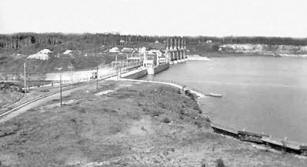 |
The
temporary house was on the hill behind the Staff House and was
perched on the edge of an eroding clay cliff. It may have been
precarious, but the view was magnificent.
The
picture on the left is the view from our front porch. |
| On the right - my father and I
are climbing up the cliff after going for a swim. Note the swim
suit style. |
|
 |
|
|